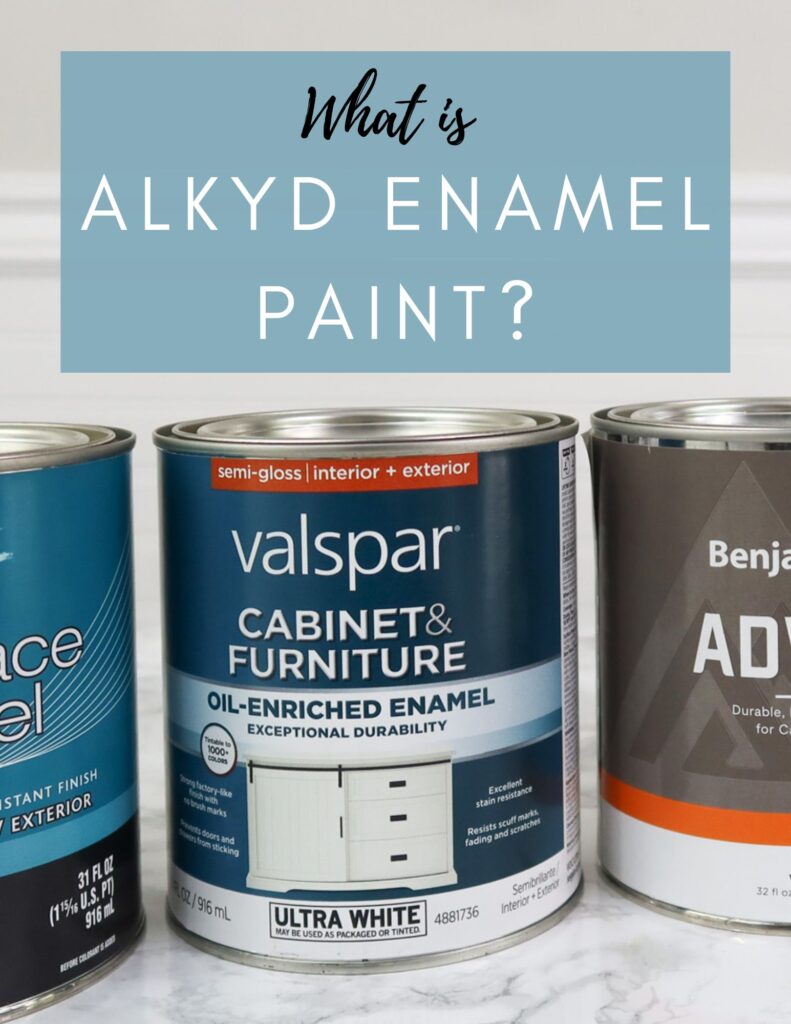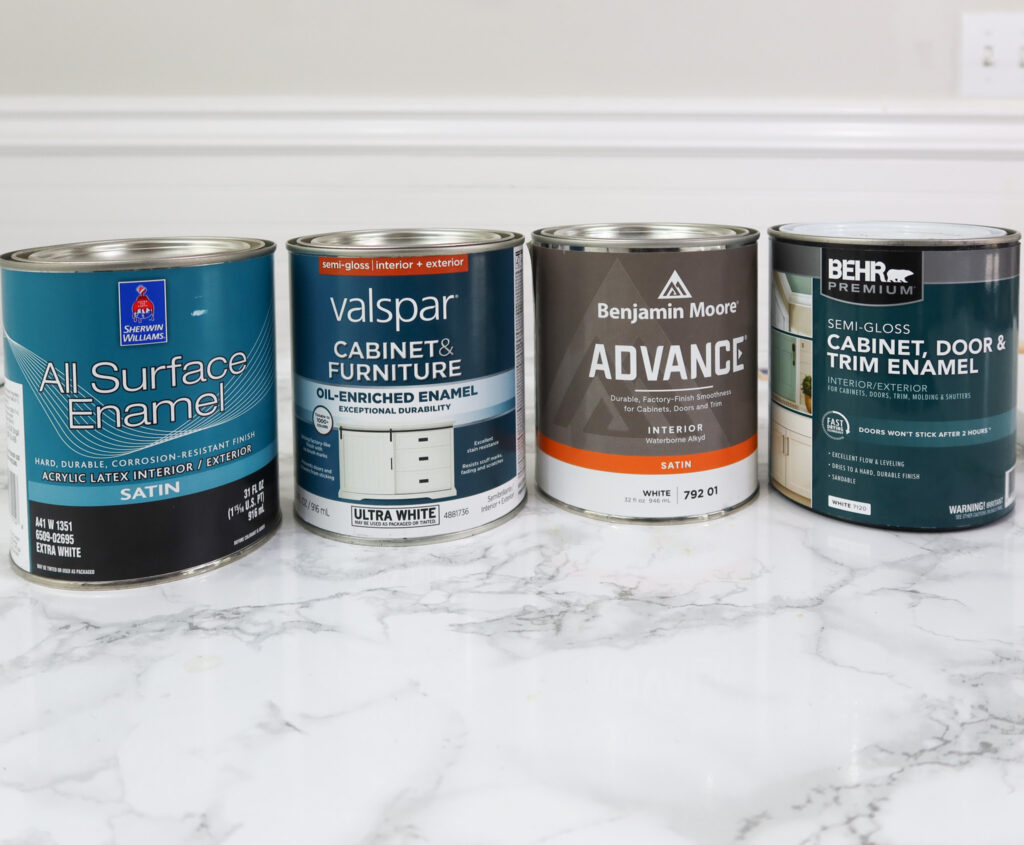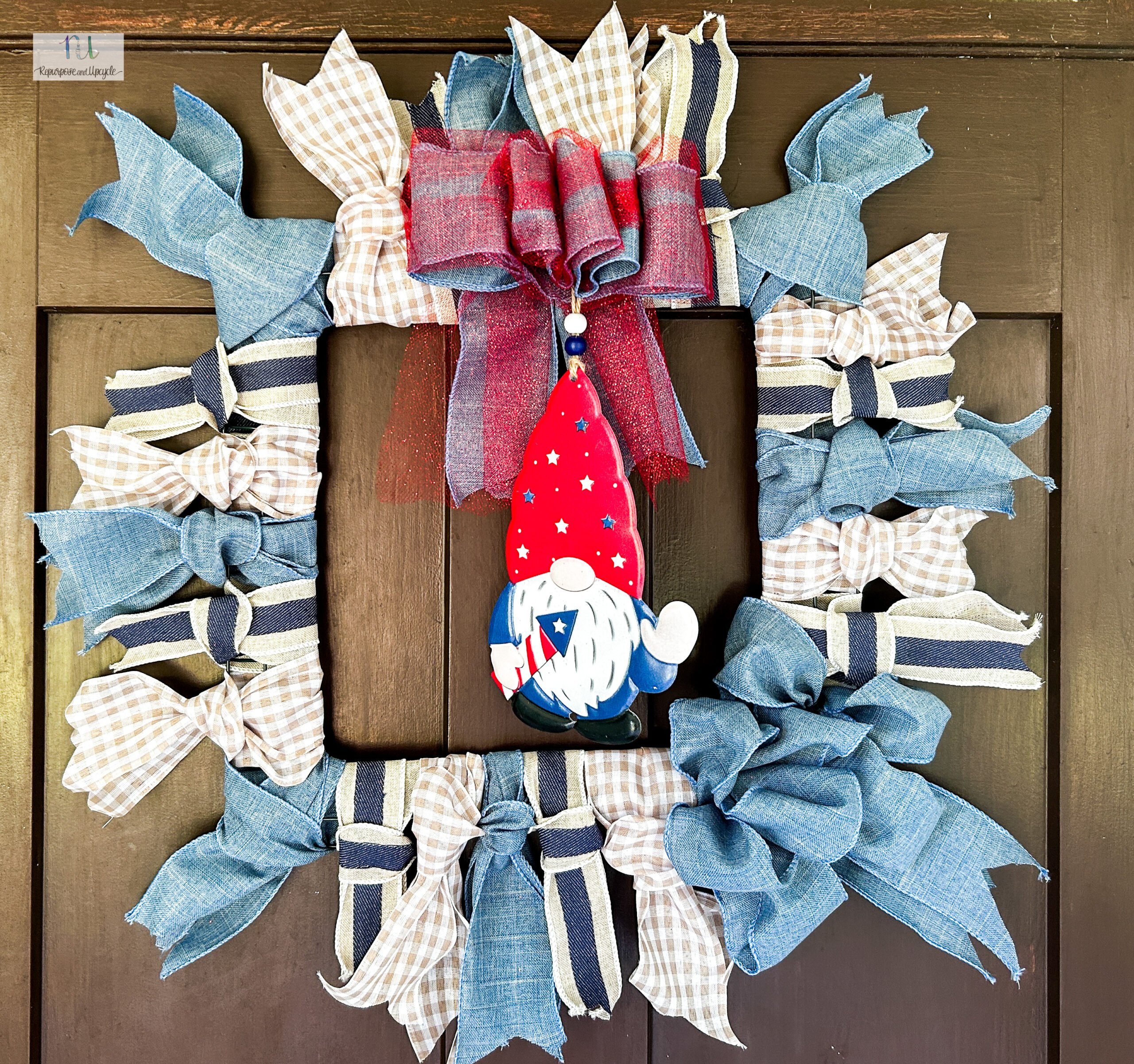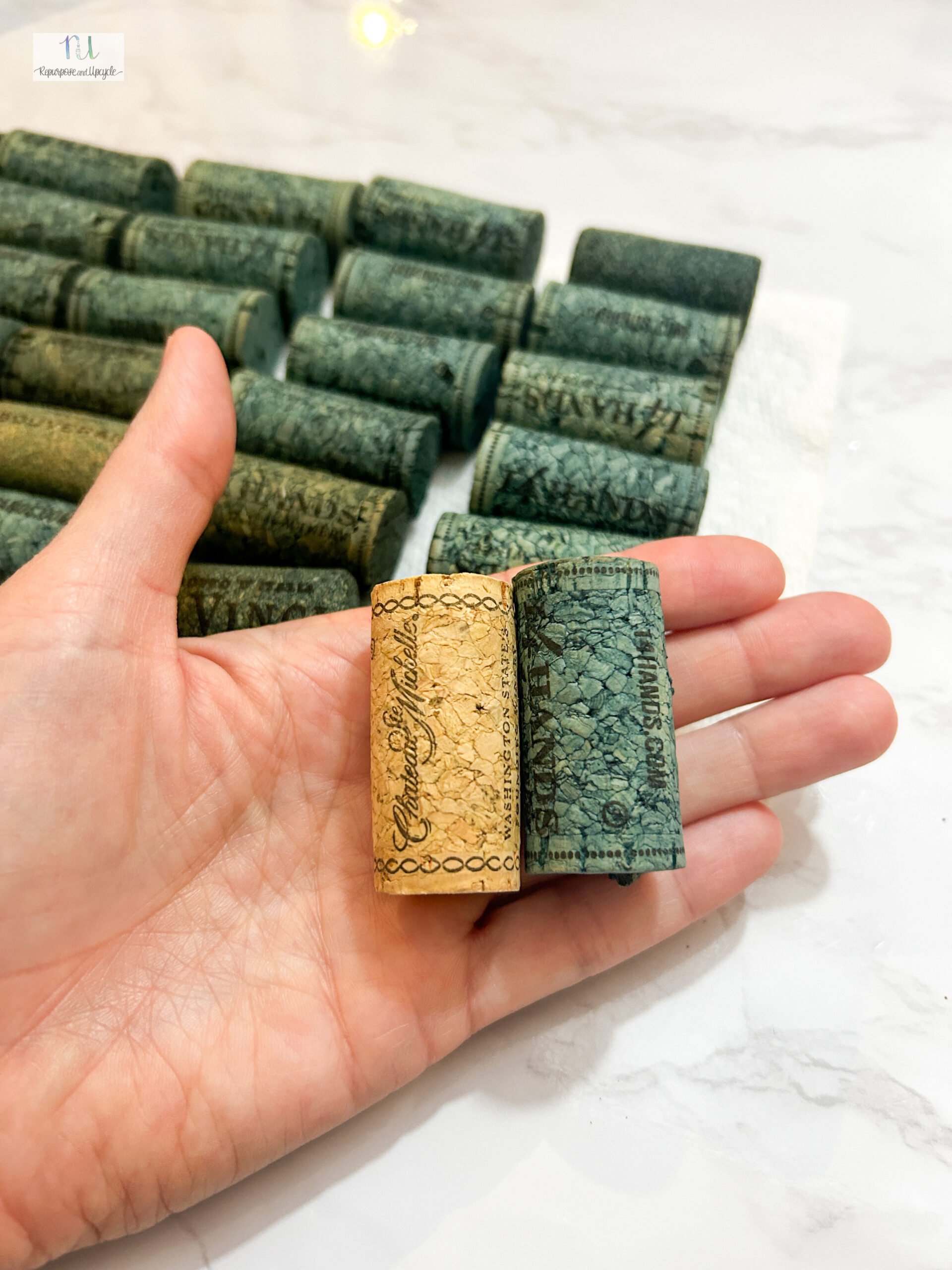Alkyd enamel paint; what is it and what does it do? I’ve used many different types of paint over the years and this particular type of paint is starting to show up in most home stores everywhere.
In a nutshell, alkyd enamel paint is a type of oil-based paint that is known for its durability and (most of the time) glossy finish. It is made by combining alkyd resin, a type of synthetic polymer, with pigment and solvent. It’s often used to paint cabinets because of its durability.
One of the benefits of alkyd enamel paint is its ability to adhere to a variety of surfaces, including metal, wood, and concrete. It is also resistant to chipping, peeling, and fading, making it a great choice for high-traffic areas or surfaces that get a lot of use like kitchen cabinets and interior wood trim. Also, alkyd enamel paint has a quick dry time and can be recoated within a few hours, which can save time on larger painting projects.

Understanding Alkyd Enamel Paint
Alkyd enamel paint is a synthetic resin that is made by reacting oil or fatty acids with a polyol. This results in a paint that is more durable and resistant to wear and tear than traditional oil-based paints and even better than latex paints and water-based paints.
One of the main advantages of alkyd enamel paint is its ability to dry quickly. This makes it ideal for use in areas where a quick turnaround time is needed. Quick dry alkyd enamel also has excellent adhesion properties, which means that it can be used on a variety of surfaces, including metal, wood, and masonry (even exterior use) without a lot of prep work.
Another advantage of alkyd enamel paint is its durable finish which makes it great for a high traffic surface. It has excellent resistance to moisture, which makes it ideal for use in areas that are exposed to water, such as bathrooms and kitchens.
Alkyd enamel paint is available in a wide range of colors and finishes, including gloss, semi-gloss, and satin. The gloss enamel sheens are typically the most durable. It can be applied using a brush, roller, or spray gun, depending on the surface and the desired finish. No wonder tons of professional painters love this stuff!
Composition of Alkyd Enamel Paint
Alkyd enamel paint is a type of oil-based paint that is made up of a combination of resins, oils, and solvents.
The main components of alkyd enamel paint are:
- Resins: Resins are the primary component of alkyd enamel paint. They are responsible for the paint’s adhesion, durability, and glossiness. Alkyd enamel paint typically contains a combination of long-chain fatty acids, pentaerythritol, and phthalic anhydride.
- Oils: Oils are used to dissolve the resins and make the paint more fluid. Alkyd enamel paint typically contains a combination of linseed oil, soybean oil, or other vegetable oils.
- Solvents: Solvents are used to thin the paint and make it easier to apply. Alkyd enamel paint typically contains a combination of mineral spirits, turpentine, or other solvents.
Alkyd enamel paint may also contain other additives such as pigments, driers, and thickeners. Pigments are used to give the paint its color, while driers are used to accelerate the drying process. Thickeners are used to adjust the viscosity of the paint.
Properties of Alkyd Enamel Paint
Here are some of the key characteristics of conventional alkyd enamels:
- Durability: Alkyd enamel paint is known for its excellent durability, making it a popular choice for high-traffic areas. It is resistant to chipping, cracking, and peeling, and can withstand exposure to harsh weather conditions. I love a paint that can withstand our brutal summers. Bring on that higher humidity!
- Glossy Finish: Alkyd enamel paint provides a glossy finish that can enhance the appearance of surfaces. This finish is achieved by the use of alkyd resins, which create a hard, glossy surface when they cure.
- Fast Drying: Alkyd enamel paint dries quickly, which can be an advantage in situations where fast turnaround times are required. However, it is important to note that the drying time can vary depending on factors such as temperature and humidity.
- Ease of Application: Alkyd enamel paint is easy to apply using a brush, roller, or spray gun. It can be applied to a variety of surfaces, including wood, metal, and concrete.
- Resistance to Stains and Chemicals: Alkyd enamel paint is resistant to stains (like mildew stains) and chemicals, making it a popular choice for industrial and commercial applications. It can withstand exposure to oils, solvents, and acids, and is easy to clean.
Uses and Applications of Alkyd Enamel Paint
Alkyd enamel paint is commonly used in the industrial, automotive, and marine industries due to its durability, resistance to weathering, and ability to adhere to a wide range of surfaces. Here are some of the most common uses and applications of alkyd enamel paint:
- Automotive Industry: Alkyd enamel paint is often used in the automotive industry to paint cars, trucks, and other vehicles. It provides a glossy finish that is resistant to chipping, peeling paint and fading, making it ideal for use on exterior surfaces. It can also be used as an interior paint for cars, such as dashboards and door panels.
- Industrial Applications: Alkyd enamel paint is commonly used in the industrial sector to paint machinery, equipment, and other metal surfaces. It provides a protective coating that helps prevent rust and corrosion, making it ideal for use in harsh environments.
- Marine Industry: Alkyd enamel paint is also used in the marine industry to paint boats, ships, and other watercraft. It provides a durable, weather-resistant coating that can withstand exposure to salt water, sun, and other harsh conditions.
- Architectural Applications: Alkyd enamel paint can also be used in architectural applications, such as painting doors, trim, and other wood surfaces. It provides a smooth, glossy finish that is resistant to wear and tear.
Even though it’s popular and durable with these commercial industries, it makes a great kitchen and bathroom cabinet paint too!
One thing to note; if you are painting a metal surface, make sure that the specific paint you are using is compatible with the type of metal you are painting. Certain alkyd paints are only compatible with non-ferrous metals. On the flip side, ferrous metal substrates are only compatible with certain types of alkyd paint.
Benefits of Alkyd Enamel Paint
Alkyd enamel paint has a number of benefits that make it a popular choice for both a residential and a commercial painting project.
- Durability: Alkyd enamel paint is known for its durability and resistance to wear and tear. It can withstand harsh weather conditions, moisture, and abrasions, making it ideal for high-traffic areas.
- Versatility: Alkyd enamel paint can be used on a variety of surfaces, including metal, wood, and concrete. It is also available in a wide range of colors and finishes, making it easy to find the perfect match for any project.
- Ease of Application: Alkyd enamel paint is easy to apply and dries quickly, allowing for faster completion of painting projects. It also has good leveling properties, which means that it dries to a smooth, even finish without brush marks or brush strokes.
- Resistance to Stains: Alkyd enamel paint is resistant to stains, making it a good choice for areas that are prone to spills and messes. It can be easily cleaned with soap and water, making it a low-maintenance option.
- Affordability: Alkyd enamel paint is an affordable option compared to other types of paint. It offers a good balance of quality and cost-effectiveness, making it a popular choice for both DIY and professional painting projects.
Drawbacks of Alkyd Enamel Paint
Alkyd enamel paint has several drawbacks that need to be considered before deciding to use it.
First, alkyd enamel paint emits a strong odor during application and takes a long time to dry. The paint contains solvents that evaporate during the drying process, which can cause health problems if inhaled in large quantities. This is not a low VOC paint.
Second, alkyd enamel paint is not very environmentally friendly. The solvents used in the paint can contribute to air pollution and are not biodegradable. This means that the paint can have a negative impact on the environment if not disposed of properly.
Third, alkyd enamel paint is prone to yellowing over time. This is especially true when the paint is exposed to sunlight or high temperatures. The yellowing can make the paint look unsightly and can also affect the color of any objects painted with the paint.
Comparison with Other Paint Types
Alkyd enamel paint is a popular choice for many painting projects. When compared to other types of paint, alkyd enamel paint has some distinct advantages:
- Oil-based paint: Alkyd enamel paint is often compared to oil-based paint due to its similar properties. It also has a lower VOC content (volatile organic compounds) than traditional oil-based paints, making it a more environmentally-friendly option.
- Latex paint: While latex paint is a popular choice for many DIY projects, it is not as durable as alkyd enamel paint. Latex paint is more prone to chipping and peeling, especially in high-traffic areas. Alkyd enamel paint, on the other hand, forms a hard, glossy finish that is resistant to wear and tear.
- Acrylic paint: Acrylic paint is another popular choice for DIY projects, but it lacks the durability of alkyd enamel paint. Acrylic paint is more prone to fading and chalking over time, especially when exposed to sunlight. Alkyd enamel paint, on the other hand, has a high color retention.
What is a Hybrid Alkyd Enamel?
Hybrid Enamels are a type of paint that combines the benefits of both alkyd and acrylic paints. Conventional alkyd paints or traditional Alkyd enamels are known for their durability and resistance to wear and tear, while acrylic paints are known for their fast drying time and low odor. A hybrid alkyd enamel is a water-based paint that contains both alkyd and acrylic resins, which gives it the durability of an alkyd paint and the fast drying time and low odor of an acrylic paint. This type of paint is commonly used on surfaces that require a tough, long-lasting finish, such as metal and woodwork.
Brands of Alkyd Enamel Paints
There are several well-known brands of Alkyd Enamel paints available in the market. Here are a few examples:
- Benjamin Moore rapid dry Alkyd Enamel
- Sherwin-Williams Pro Industrial Alkyd Enamel
- Rust-Oleum Professional High-Performance Enamel
- Behr Urethane Alkyd enamel in Semi-Gloss
- PPG Break-Through! Alkyd Enamel
- Valspar Anti-Rust Armor Alkyd Enamel
- Krylon Industrial Quik-Mark Alkyd Enamel and Rust Tough® Rust Preventive Enamel
- Zinsser AllCoat Exterior Satin Alkyd Paint
- Dulux Alkyd Enamel
- Jotun Alkyd Enamel
I recently wrote a post about the best white cabinet paints, and a few of them were an alkyd enamel paint.

I hope this post has helped you to understand a little more about these types of paints!
Thanks for stopping by friends.





